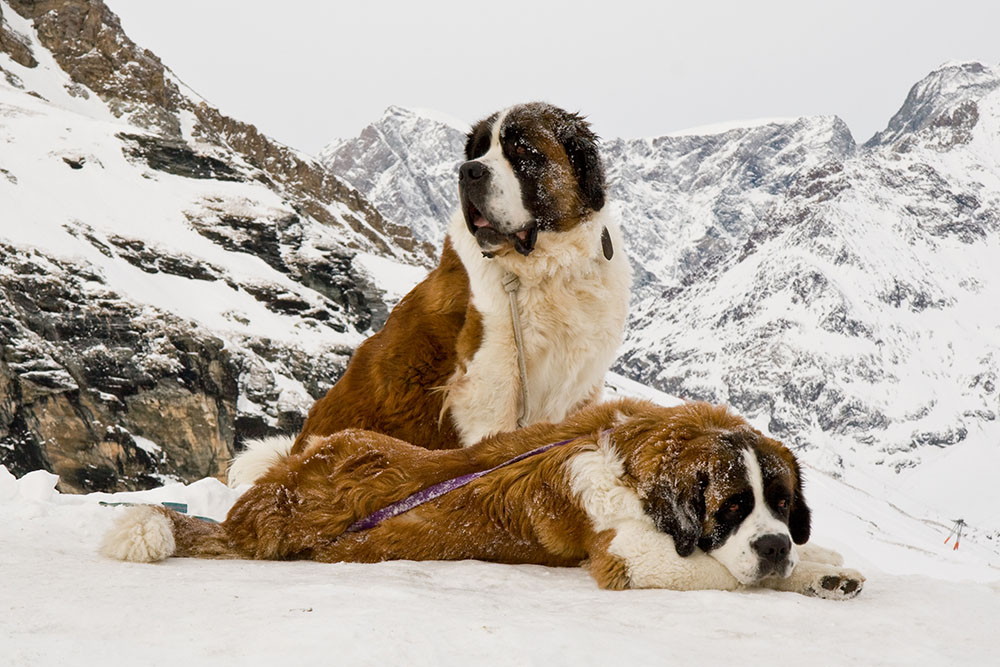Breed Profile – St Bernard
26/12/2016
Originating in the Swiss Alps, the St Bernard is now popular worldwide. This ‘gentle giant’ has a lovely nature but could eat you out of house and home!
History of Breed: The St Bernard was originally a crossbreed of mastiff-type dogs, in particular the Alpine Mastiff. The Alpine Mastiff is also the ancestor of the English Mastiff. The St Bernard can also count the Bernese Mountain Dog, Newfoundland and Great Dane among its ancestry. The monks of St Bernard’s Hospice in the Swiss Alps developed the breed as a guard dog, but it soon gained a reputation as a rescue dog. The 1992 film ‘Beethoven’, which featured a St Bernard, saw a surge in popularity for the breed.
Life Expectancy: 8-10 years.
Size: A large dog with a height range of 70-75cm and a weight range of 59-81kg.
Features: Well-proportioned and solid, the St Bernard has a broad, muscular body and long, strong legs. The coat is rough or smooth. In smooth varieties, it is close in texture with slight feathering to thighs and tail. In rough varieties, it is dense and flat with lots of feathering and fuller fur round the neck. The coat comes in orange, mahogany-brindle or red-brindle with characteristic markings. These are: white collar, chest, forelegs, feet, end of tail, muzzle and a white blaze on the face, with black shadings to the face and ears. The flat, deep cheeks with pronounced dewlap give the St Bernard a distinct, sorrowful expression.
Energy Levels/Exercise Required: The St Bernard requires about an hour of exercise per day. It is a breed known for its stamina and endurance levels rather than the boundless energy of smaller working dogs. Being a large and, in the case of the rough-haired St Bernard, hairy breed of dog, exercising in hot weather needs to be carefully monitored. Naturally adequate exercise is important to prevent excessive weight gain, but keeping an eye out for the signs of heatstroke and cooling down slowly after exercise is essential.
Potential Health Problems: Owners of large or giant breeds need to be aware of the rapid growth during puppyhood that can lead to bone and joint problems if not handled correctly. A specialist diet and careful exercise is essential for this breed. Hip and elbow dysplasia is an inherited disease that can cause problems as well. Gilbertson & Page have several feeds appropriate for large and giant breeds, including Gilpa Kennel, which contains New Zealand green-lipped mussel extract to maintain joint and bone health. It also has a larger biscuit size to suit the larger mouth size of these breeds.
Temperament: The St Bernard is a steady, kind and intelligent breed. They are loyal, protective and courageous. Training and socialisation must be carried out in a firm, friendly way whilst young. An unruly giant dog is much harder to control!
Family Dog/Child Friendly: With their affectionate and trustworthy natures, St Bernard’s make great family dogs. They are very good with children, although it is wise to supervise large dogs and very small children to avoid injury by inadvertent crushing. The St Bernard is happiest in a large house with plenty of room, though they don’t necessarily require a lot of outdoor space. It is also important to take into account the huge amount of food that they can get through before committing to own a dog of this size.
Likes: Attention, family life, cold weather.
Dislikes: Hot weather(!), lack of attention and exercise.



